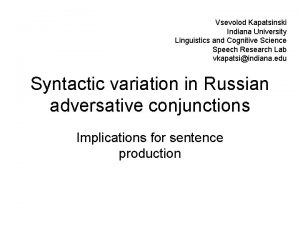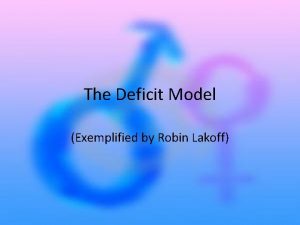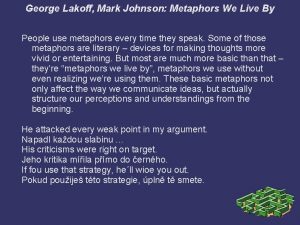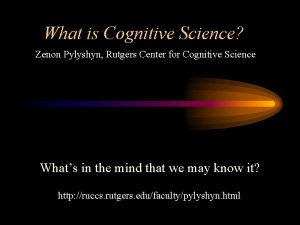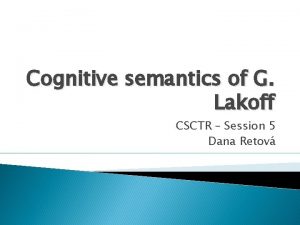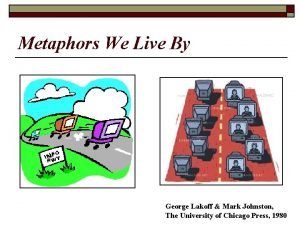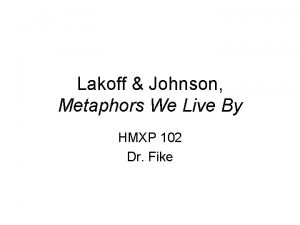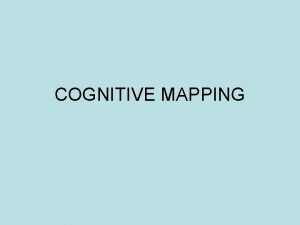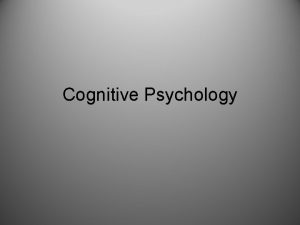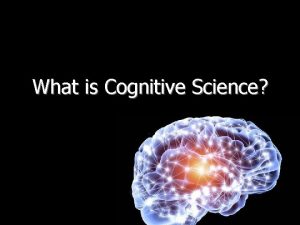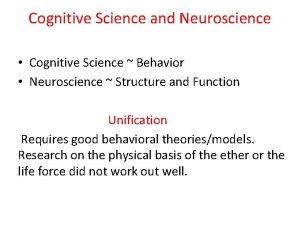The Cognitive Science of Politics George Lakoff University






















- Slides: 22

The Cognitive Science of Politics George Lakoff University of California, Berkeley

The Conservative Communication System Everywhere in US 24/7/365 Think tanks, with Radio & TV studios, researchers, publications, blogs, & “experts” Language experts: framers, focus groups, surveys to find and test effective language Strategists, Pollsters, Ad agencies Training Institutes Weekly meetings, to coordinate positions and messages Talking points, with computer distribution lists Speakers: “Experts, ” political leaders, pundits, businessmen, strategists Media: TV and talk radio stations, newspapers, blogs, magazines, book publishers Lecture circuits: Colleges, corporations, business conferences, local symposia Local Institutions: Chambers of commerce, churches, VFW’s, political clubs Booking agencies: Booking Speakers every day on Media to address Talking Points 1.

Real Reason vs. The Myth of Enlightenment Reason Real: 98% Unconscious — partly universal, largely varying Myth: 100% Conscious — Universal; everyone reasons the same way Real: You think with your brain; thought is physical; embodied in circuitry Myth: Thought is abstract; not physical Real: Indirect – Constrained and enabled by body, brain, and interactions Myth: Fits the world directly Real: Emotion is necessary for rationality Mythical: Emotion gets in the ways of rationality Real: Reason uses frames, conceptual metaphors, and narratives Myth: Reason uses classical logic Real: Reason serves empathy as well as self-interest Myth: Reason serves self-interest Real: Language is defined by frames Myth: Language directly fits the world

Why the View of Reason Matters If you understand Real Reason, you will see the need for an extensive system of communications and the need for systematic attention to framing. If you believe the Enlightenment Myth about reason, you will believe that all that is necessary is telling the truth — or “spinning” when the truth is embarrassing. � Since everyone will reason the same way to the right conclusions, no elaborate training or communications system is necessary. You will also think that a communications system can only be a propaganda system, which progressives find illegitimate. Conservatives, in college, tended to study business and marketing. Marketing professors tend to know about real reason. Progressives, in college, tended to study political science, economics, public policy, law, and sociology — all of which assume the Enlightenment Myth about Reason. Conservatives thus have an advantage over progressives.

Administering requires a serious communications system, close attention to the moral basis of policies, and to consistent and effective framing in every policy area

Progressive Moral Principles Democracy begins with empathy, with citizens caring about each other. It requires citizens to take responsibility, both personal and social, to act on that empathy so as to make the lives of others, as well as their own lives, better. This holds in family life, as well as in social and political life. It requires democratic institutions that both permit and promote this, e. g. , institutions of government, media, commerce, education, social organization, etc. And it requires an ethic of excellence: making oneself better, and making one’s family, community, and nation better. Government has twin moral missions: the protection and enablement of citizens and of those institutions.

Protection goes beyond military, police and disaster protection to protection for consumers, workers, investors, the environment, health, pensions, and so on. Protection includes maximizing freedom, fairness, equality under the law, and the guarantee of basic rights, e. g. , speech, political participation, etc. Fairness for all requires minimizing disparities of wealth and political power. Freedom for all requires maximizing the well-being of all. Enablement includes education; public works such as roads, buildings, and parks; electrical delivery, water, and sewage systems; affordable housing; a functioning economic and banking system; the promotion and regulation of commerce; the promotion of art and culture; and a legal and judicial system. No one can earn a decent living and live well without protection and empowerment by government. Taxes are what you pay for protection and empowerment by your government.

Conservative Moral Principles Conservatism sees a republic as based on a hierarchy of legitimate authority deriving from merit: individual responsibility, talent, discipline, and achievement in a free market. The (strict father) family is the basis of society, and it too is based on legitimate parental authority. The right to pass on wealth on to progeny and for families to accumulate wealth is central to family life. Religion is the basis of morality. Religion should function freely. Corporations are the fundamental institutions of wealth creation and maintenance. The role of government is limited to the protection of life, liberty, and property and the promotion and protection of family life, religion, and commerce in a free market. The promotion and protection of these principles is of the highest priority.

All politics is moral. Moral principles define what is “right” about policies. Policies are thus in the service of moral principles.

My Guess About Zapatero, like most progressives, is not good at articulating the moral basis of his actions. Zapatero seems to be adhering to progressive moral principles. He has been concentrating on protection, and is moving to empowerment. He sees the Spanish economy as being under attack by financial institutions. To protect the nation’s economy, he has convinced the Central European Bank to support them. To show that Spain’s banks are solvent, he has obtained the release of results of stress tests on banks. As part of the deal with the Central European Banks, he has agreed to cut back modestly on pensions for public employees, which had gone up 24% since he came to office. They will still be much higher than before he came to office. His lower-level policy was to maintain pensions. But to protect the Spanish economy from attack, including protecting the overall well-being workers, he has had to change that policy somewhat. He maintained the higher-level progressive moral principles while changing the lower-level policy. He has not explained this at all.

Bi-conceptualism Moral systems are complex neural circuits. Contradictory moral systems can reside in the same brain, with mutual inhibition — the activation of one inhibits the other. A significant number of people have both strict and nurturant moral systems — triggered in different contexts and applying to different issues. For example, someone may be conservative on economic policy and progressive on social issues, or conservative on foreign policy and progressive on domestic policy. All sort of combinations exist. Thus, there is no simple left-to-right spectrum, no “center, ” no consistent ideology of the “middle” of the “moderate. ” Instead, there are different mixtures of conservative and progressive values. In Europe, this leads to multi-party systems. In America, it leads to within-party struggles.

Conceptual Frames, Metaphors, and Narratives Brain Circuits We Use to Think With Frames structures situations. A Frame has Roles, Relations Among Roles, and links to other frames. Metaphors are circuits mapping frames onto other frames, preserving inference. Narratives are Frame-Sequences with the same roles able to occur throughout the sequence. There is usually a special roles that one identifies with, called the protagonist. The narrative is typically understood from the protagonist’s point of view. Frames within a narrative are typically linked neurally to emotional regions, providing conventional emotional responses. Frames, metaphors, and narratives can combine via neural binding to form complex cognitive structures. They also form hierarchies, with general and special cases. In political thought, the moral systems sit atop the hierarchy of frames, metaphors and narratives and are activated whenever those are activated.

The Difference Between Framing and Messaging Framing is the most commonplace thing we do with thought and language. Frames are the cognitive structures we think with. They are physical, embodied in neural circuitry. Frames come in systems. Their circuitry is strengthened and often made permanent through use: the more the circuits are used, the stronger they get. Effective frames are not isolated. They build on, and extend, other frames already established. All words are defined in terms of conceptual frames. When the words are heard, the frames are strengthened — not just the immediate frames, but the whole system. Fit matters. The brain is a “best-fit” system. The better a new frame “fits” existing frames, the more effective it will be; that is, the more people will think, and make decisions, using that frame.

Frame conflict The activation of one brain circuit may either activate or inhibit another. A frame that fits a system will activate other frames in the system and make them stronger. Strongly activated frames will weaken frames that they inhibit. There are progressive and conservative frame systems. Activating the conservative frame system, weakens the progressive frame system — both individual frames for particular issues, but also the system as a whole. That is how framing works. There are consequences. High-Level Moral Frames Matter More Higher-level frames, deeper in the system, have a disproportionate effect. The more the language of frame is repeated, the stronger the frame gets, along with the system the frame is in. And the weaker the frames of the contradictory system gets. The stronger high-level frames are, the more effective frames that fit them will be. And the less effective frames that contradict them will be. In politics, the high-level frames are the moral systems that define what is “right” for a conservative or progressive.

Contested concepts In politics, the high-level frames are moral frames. There are opposing conservative and progressive moral systems. Important political concepts are “contested, ” overlapping in some classic cases, but diverging in content depending on the moral system. Thus, vital political concepts like Life, Freedom, Responsibility, Government, Accountability, Equality, Fairness, Empathy, Property, Security, and so on are contested. A major goal of political framing is to get your version of contested concepts accepted by the voters. Messaging can then use these concepts and their language freely and effectively. That is how framing works generally — independent of whether the frames are used in politics. In politics, bi-conceptual voters can shift back and forth on an issue, depending on how the issue is framed in terms of higher-level political systems.

Language All words are defined with respect to frames. When you hear the word the frame circuitry in your brain is activated, and whenever a frame is activated, the synapses grow stronger. Frames come in systems. Systems of political frames are structured by political moral systems. Political language activates frames, which activate other frames in the system, which then activate the frames in the moral system — and thus all the activated frames become stronger. Repeated political language strengthens not just the political frames, but the moral system that defines the political ideology. That is why the choice of language and the repetition of language is so important. That is also why one should never use the political language of the other side, even to negate it or to argument against their arguments. Ideology is in the brain. A fact that contradicts one’s system of frames will be not be assimilated. The fact will disappear, the frames will stay. The truth

Political Messaging Messages use words. The words activate frames. In political messages, you have a double intention: to get voters to think using your frames and to keep voters from thinking using the other side’s frames, which contradict yours. Your message will be more effective if it fits existing high-level frames in the brains of voters, and less effective it contradicts such high-level frames. Political messaging and bi-conceptual voters Your goal, with bi-conceptual voters, is to activate your system of political frames and inhibit the other side’s system of political frames. Your message should therefore fit your high-level frame system, and it should not fit the other side’s high -level frame system. If it fits the other side’s high-level frame system, your message will be helping the other side, because it will tend to make voters think using their frame system.

Why Does Disaster Messaging Arise? Suppose the other side has structured its messaging over a long period of time to consistently strengthen its high-level frames, prototypes, and versions of contested concepts in the brains of voters. They can now do effective messaging by using those high-level frames in messages that evoke the existing strong high-level frames. Why Conservatives Consistently Win Messaging Battles In the US, conservatives have set up an elaborate messaging system. There are conservative media going on 24/7/365. As a result conservative language is heard constantly in many parts of the US. Conservative language automatically and unconsciously activates conservative frames and the high-level systems they are part of. As the language is heard over and over, the circuitry linking the language to conservative frames becomes progressively stronger. Because the synapses in the neural circuits are stronger, they are easier to activate. As a result, conservative language tends to become the normal, preferred “mainstream” language for discussing current issues.

Polling and The “Mainstream” When the Democrats are out-messaged, they call upon polling and focus groups to given an “empirical, evidential” account of public opinion and which language is preferred by the public. The “evidence” comes from polls and focus groups that test the normal “mainstream” language and logic, versus language and logic that is not “mainstream. ” This is, all too often, conservative language and logic, because the conservative messaging system has systematically made it that way patiently over years. The pollsters therefore report that the “mainstream” of Americans prefer the conservative language and logic, and the policies that go with them. The pollsters then suggest moving to right to go to where the public is. They then construct and test messages that move enough to right to satisfy the “mainstream. ” They also construct “good arguments. ” If the “good arguments” activate the conservative worldview, the conservative position will just get stronger in the brains of the voters.

What’s Wrong? When the Democrats use conservative language, they activate more than the conservative framing on the given issue. They also activate and strengthen the high level, deep conservative moral frames. This tends to make voters more conservative overall — and leads them to choose the real conservative position on the given issue, rather than the sort of conservative version provided by the democrats. Disaster framing is a disaster.

Campaigning Don’t: give long laundry lists of policies appealing to their self-interests. Such lists bore voters and are not memorable. Voters care about 5 things: Values — any discussion of an issue must be discussed from a moral perspective Connection and clear effective communication Authenticity – are you saying what you believe? Trust — If you know a candidate’s values, if he is authentic and communicates with you, then you can trust him. Identification — If all the above is true, then you can identify with the candidate.

Polling Traditional reason assumes the Myth of Enlightenment Reason: • People are conscious of their opinions • Opinions are literal (no framing, no metaphors) • There is a left, right, and center. • There are “undecideds” • Voters follow Enlightenment reason; they vote according to self-interest. • Framing is irrelevant • There is no bi-conceptualism (and hence it is not tested for, even though the numbers of bi-conceptuals are significant Real reason contradicts all of the above. Polls need to pay close attention to moral systems, framing, and biconceptualism.
 George lakoff framing
George lakoff framing Indiana university cognitive science
Indiana university cognitive science Cognitive and non cognitive religious language
Cognitive and non cognitive religious language Robin lakoff
Robin lakoff Robin lakoff
Robin lakoff Todesfuge rhetorische mittel
Todesfuge rhetorische mittel My favorite subjects
My favorite subjects George washington vs king george iii
George washington vs king george iii Venn diagram george washington and king george iii
Venn diagram george washington and king george iii Zenon pylyshyn
Zenon pylyshyn Contoh psikologi kognitif
Contoh psikologi kognitif George mason university health administration
George mason university health administration Gwu student accounts office
Gwu student accounts office Gwu electrical engineering
Gwu electrical engineering Off campus housing george mason
Off campus housing george mason George mason registration
George mason registration Eli gmu
Eli gmu George mason orientation
George mason orientation George blank university
George blank university George washington university electrical engineering
George washington university electrical engineering Hình ảnh bộ gõ cơ thể búng tay
Hình ảnh bộ gõ cơ thể búng tay Lp html
Lp html Bổ thể
Bổ thể

